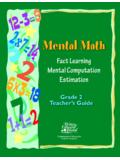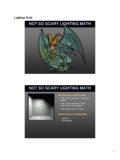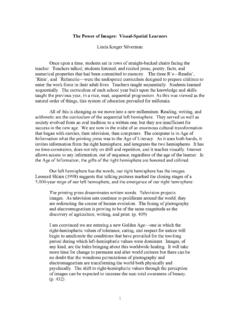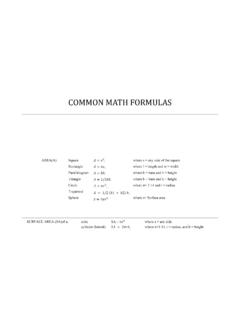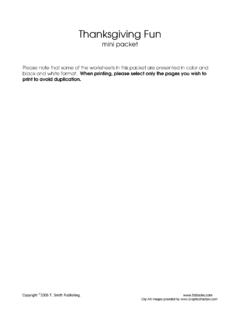Transcription of Writing Across the Curriculum - michigan.gov
1 Writing Across the Curriculum Click To Find: English Language Arts Social Studies Science The Arts Mathematics Introduction: Writing Across the Curriculum What is it? Teachers Across the disciplines use Writing -to-learn and Writing -to demonstrate- knowledge to enhance the learning of students in all disciplines. Basic Principles of Writing Across the Curriculum (WAC) In response to the need of students to learn content using a variety of strategies and their need to practice Writing in a variety of contexts, many teachers have adopted the strategies associated with WAC. The following principles underlie WAC: Writing promotes learning. Integration of Writing and the Writing process promotes student participation, a diversity of student voices, and engages students as critical thinkers while promoting their texts as important resources and thinking tools.
2 Effective Writing instruction integrates disciplines. The opportunity to write in every class develops good writers. Using Writing as part of instruction can be used in every classroom. Only by practicing the thinking and Writing conventions of an academic discipline will students begin to communicate effectively within that discipline. What's In It For Teachers and Students? Including Writing in instruction has short- and long-term benefits. In the short term, students and their teachers are better able to appraise how well they grasp information and where deeper elaboration of key concepts is needed. Students are able to take small pieces of content and analyze it looking for patterns and connections.
3 In the long run, students who use Writing as a technique to learn content develop their skills as thinkers. Organization, summary, and analysis of content become easier for students, producing richer understandings. Students become more practiced at using Writing to communicate their learning and thinking. Writing is used to initiate discussion, reinforce content, and model the method of inquiry common to the field. Writing can help students discover new knowledge to sort through previous understandings, draw connections, and uncover new ideas as they write. Writing -to-learn activities encourage the kind of reflection on learning that improves students metacognitive skills. The key to effectively using Writing activities in every subject lies in matching the right activity to the learning situation.
4 As you select Writing strategies, ask yourself: How well suited is this task for the objective the students are learning? Does this strategy fit my students abilities and needs? Will this strategy complement the way my students will be assessed on content later? Assigned Writing in all classes and courses helps students keep their Writing skills sharp. Students become better readers, thinkers, and learners in a discipline by processing their ideas through Writing . Writing assigned Across the Curriculum also helps students prepare for the day-in and day-out communicative tasks they'll face on the job, no matter what the job is. Equally important, students need to learn about how Writing is used within a discipline; and utilizing many different kinds of Writing assignments gives students practice with a variety of disciplinary forms and conventions.
5 So, why assign Writing in your classes? Students will learn more content, will clarify their thinking, and will leave your classroom better prepared to face thinking and communication challenges. 2 Definition: Writing -To-Learn A Writing -to-learn strategy is one that teachers employ throughout and/or at the end of a lesson to engage students and develop big ideas and concepts. Writing -to-learn fosters critical thinking, requiring analysis, application, and other higher level thinking skills. It is Writing that uses impromptu, short, or informal Writing tasks designed by the teacher and included throughout the lesson to help students think through key concepts and ideas. Attention is focused on ideas rather than correctness of style, grammar, or spelling.
6 It is less structured than disciplinary Writing . This approach frequently uses journals, logs, micro-themes, responses to written or oral questions, summaries, free Writing , notes, and other Writing assignments that align to learning ideas and concepts. Definition: Writing -To-Demonstrate-Knowledge A Writing -to- demonstrate- knowledge assignment is one that teachers employ when they assign reports, essays, persuasive Writing , and creative or expressive Writing , as well as research papers. When Writing -to-demonstrate-knowledge, students show what they have learned by synthesizing information and explaining their understanding of concepts and ideas. Students write for an audience with a specific purpose. Products may apply knowledge in new ways or use academic structures for research and/or formal Writing .
7 Examples include essays that deal with specific questions or problems, letters, projects, and more formal assignments or papers prepared over weeks or during a course. They adhere to format and style guidelines or standards typical of professional papers, such as reports, article reviews, and research papers, and should be checked before submitted by the student for correctness of spelling, grammar, and transition word usage. 3 Preface: WAC In Mathematics What is it? Teachers in mathematics use principles of Writing Across the Curriculum such as Writing -to-learn and Writing - to-demonstrate- knowledge to enhance the learning of students in key areas of the Curriculum . Learning mathematics is much more complex than memorizing sets of facts and examples.
8 In order to develop new and/or improved conceptual frameworks, students must be given the opportunity to process their ideas before, during, and after new learning takes place. This can be done orally, mentally, or in Writing . This document will describe for teachers a number of Writing strategies that students can use to surface their currently-held ideas and then process them in relation to new mathematical information. In addition, it is important for all mathematicians to be able to write clearly and effectively. Not only do they have to keep complete records of their ideas and work, but they also have to be able to effectively communicate their findings to worldwide audiences. Sometimes they are also expected to write grant applications and share their findings with people outside the mathematical community.
9 Teaching students to write well must be a part of any comprehensive mathematics program. Strategies that require students to demonstrate their knowledge of mathematics also provide opportunities to practice Writing for authentic audiences. In order for Writing in mathematics to impact student learning, it must be more than just copying the notes given in class. Information must be personalized in some way. Students must be expected to include reflections and questions when they write. By making these personal connections, students will begin to develop a conceptual understanding of the mathematics they are exploring in their studies. Many mathematics educators feel that students should already know how to write effectively when they come to their classrooms.
10 This is not usually the case, however. Students have learned to write from their English language arts teachers, but they usually do not know how to apply these skills to mathematics. Mathematics teachers will find that they may have to explicitly teach and provide scaffolding for each of these strategies before their students will be able to implement Writing in mathematics. 4 Teachers should implement steps from the Writing process to help students use Writing strategies effectively in mathematics: Explain the strategy and its purpose. If appropriate, describe the real-world application and audience for the product. Model how to do a sample of the expected Writing . While modeling, talk aloud about the thinking that goes on while preparing to write and during Writing .










